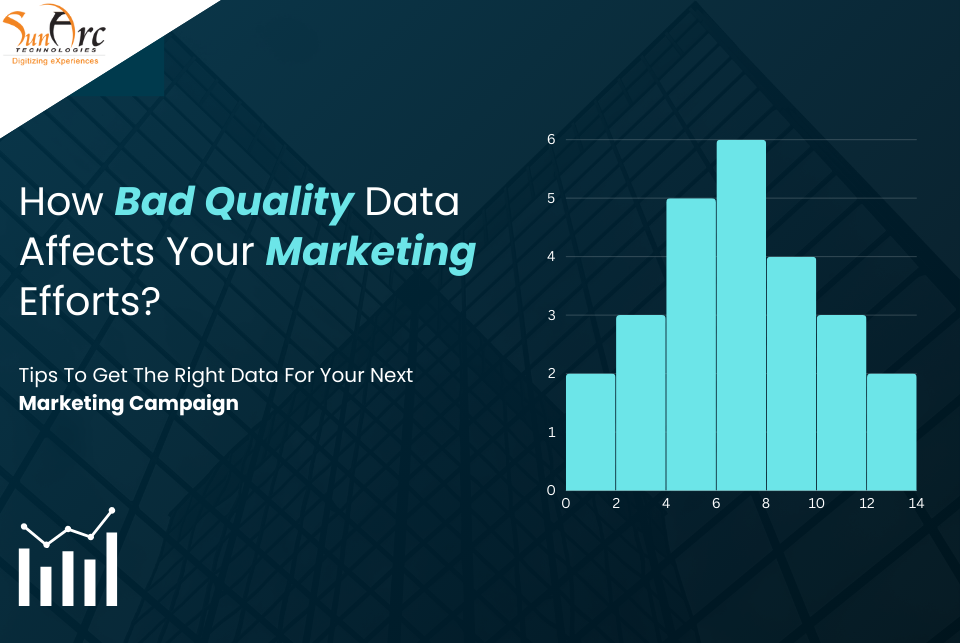You must have heard the phrase “data is the new oil”.
It fuels decision-making, drives strategy, and measures success.
But let me tell you, like oil, not all data is created equal.
Once bad-quality data enters your process it can severely hamper your marketing efforts, leading to wasted resources, missed opportunities, and flawed strategies.

In this blog, we will talk about how poor-quality data can destroy your years of marketing efforts in seconds. And what are those methods by adopting which you will get better quality data for your next marketing campaigns?
Let’s check it out..!!
The Harmful Effects of Bad Quality Data
1. Inaccurate Targeting and Segmentation
Marketing depends on precise targeting and segmentation. Bad quality data, riddled with inaccuracies, outdated information, or duplicates, leads to misdirected campaigns. This results in irrelevant messaging, lower engagement rates, and ultimately, reduced ROI.
Industry Impact:
- Retail: Misguided targeting can lead to promotions being sent to the wrong customer segments, resulting in poor conversion rates.
- Healthcare: Incorrect patient data can lead to non-compliance with regulations and ineffective patient outreach.
- Financial Services: Faulty data can cause segmentation errors, affecting customer acquisition and retention strategies.
2. Faulty Customer Insights
Quality data is essential for generating accurate customer insights. Poor data quality can distort your understanding of customer behavior, preferences, and needs, leading to misguided strategies and poor customer experiences.
Industry Impact:
- E-commerce: Inaccurate data can lead to wrong product recommendations, impacting sales and customer satisfaction.
- Travel and Hospitality: Faulty insights can result in irrelevant offers, leading to customer dissatisfaction and reduced loyalty.
- Telecommunications: Poor data quality can lead to ineffective prediction models, resulting in higher customer attrition rates.
3. Inefficient Marketing Spend
Marketing budgets are finite, and every dollar counts. Bad quality data leads to inefficient spend, as campaigns are directed toward the wrong audience, or ineffective channels, wasting valuable resources and reducing overall marketing efficiency.
Industry Impact:
- Automotive: Poor data can lead to ineffective ad placements, reducing the effectiveness of marketing campaigns.
- Real Estate: Misallocated marketing spend can result in missed opportunities in targeted property segments.
- Education: Inefficient spend can lead to missed enrollment targets and reduced funding.
4. Compromised Decision Making
Data-driven decision making is at the core of modern marketing. When decisions are based on faulty data, the outcomes are inevitably suboptimal. This can affect everything from campaign strategies to product development and customer service initiatives.
Industry Impact:
- Manufacturing: Incorrect data can lead to poor demand forecasting and inventory management.
- Energy: Faulty data can compromise market analysis and investment decisions.
- Nonprofit: Inaccurate data can affect donor targeting and engagement strategies, impacting fundraising efforts.
5. Damaged Brand Reputation
Inaccurate or inconsistent data can lead to mistakes that harm your brand’s reputation. From misspelled names in emails to sending offers to deceased individuals, these errors can significantly damage your credibility and trustworthiness.
Industry Impact:
- Media and Entertainment: Incorrect subscriber data can lead to poor personalization and damaged viewer relationships.
- Pharmaceuticals: Inaccurate data can lead to non-compliance with regulatory requirements, resulting in fines and reputational damage.
- Government: Poor data quality can erode public trust and hinder service delivery.
How to Get Better Quality Data for Marketing
Achieving better data quality requires a strategic approach, encompassing data collection, processing, and maintenance. Here are actionable steps to improve data quality for more effective marketing.
1. Implement Data Quality Management Practices
Launch data quality management practices to ensure data accuracy, completeness, consistency, and reliability. This involves setting data quality standards, regular audits, and cleansing processes.
Action Points:
- Conduct regular data audits to identify and rectify errors.
- Use data validation tools to ensure data accuracy at the point of entry.
- Establish data governance policies to maintain data quality standards.
2. Utilize Advanced Analytics and AI
Advanced analytics and AI can help in identifying data quality issues and automating data cleansing processes. Machine learning algorithms can detect irregularities, correct errors, and enhance data accuracy.
Action Points:
- Implement AI-driven data cleansing tools to automate error detection and correction.
- Use predictive analytics to identify potential data quality issues before they impact your campaigns.
- Employ machine learning models to improve data classification and segmentation accuracy.
3. Enhance Data Collection Methods
Improving data collection methods ensures that the data you gather is accurate and relevant. Use multiple data sources, employ real-time data collection techniques, and validate data at the point of entry.
Action Points:
- Use online forms with validation checks to ensure accurate data entry.
- Collect data from reliable sources, including verified third-party databases.
- Implement real-time data collection tools to capture the most current information.
4. Foster a Data-Driven Culture
Creating a data-driven culture within your organization encourages data stewardship and accountability. Educate employees about the importance of data quality and provide training on best practices.
Action Points:
- Conduct regular training sessions on data quality and management.
- Promote data stewardship by assigning data quality roles and responsibilities.
- Encourage data-driven decision-making across all levels of the organization.
5. Invest in Data Management Tools
Investing in robust data management tools can significantly improve data quality. These tools offer features like data integration, cleansing, enrichment, and governance to ensure your data remains accurate and reliable.
Action Points:
- Implement data integration platforms to consolidate data from multiple sources.
- Use data cleansing tools to regularly clean and update your datasets.
- Invest in data governance software to maintain data quality standards and compliance.
Conclusion
Bad quality data can have far-reaching negative effects on your marketing efforts, from inaccurate targeting and flawed insights to inefficient spending and compromised decision-making.
By implementing strategic data quality management practices, using advanced analytics, enhancing data collection methods, fostering a data-driven culture, and investing in robust data management tools, you can significantly improve the quality of your data.
High-quality data not only improves the effectiveness of your marketing campaigns but also drives better business outcomes and results in stronger customer relationships.
By focusing on these strategies, marketers across various industries can ensure they are utilizing reliable, accurate data to create their strategies, optimize their campaigns, and achieve their business goals.

